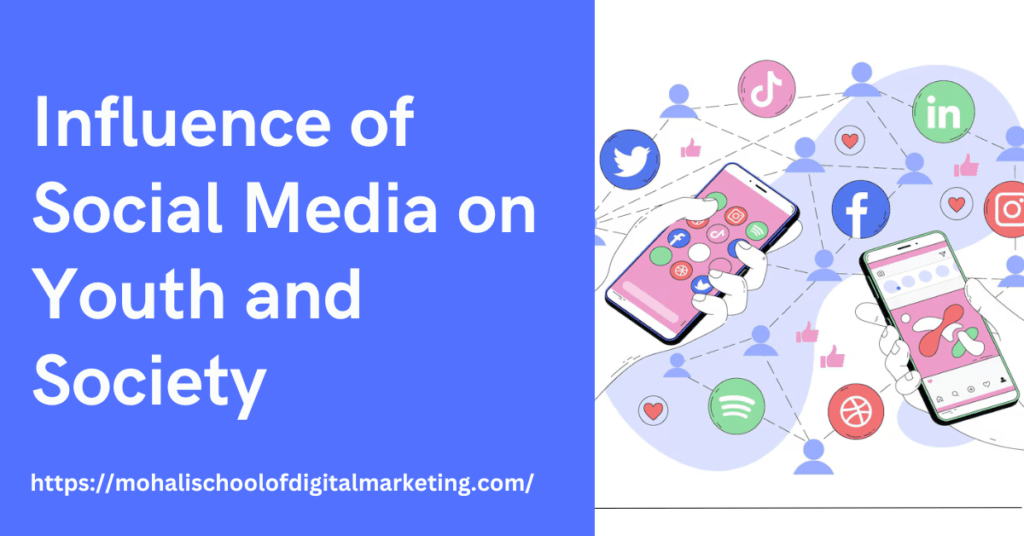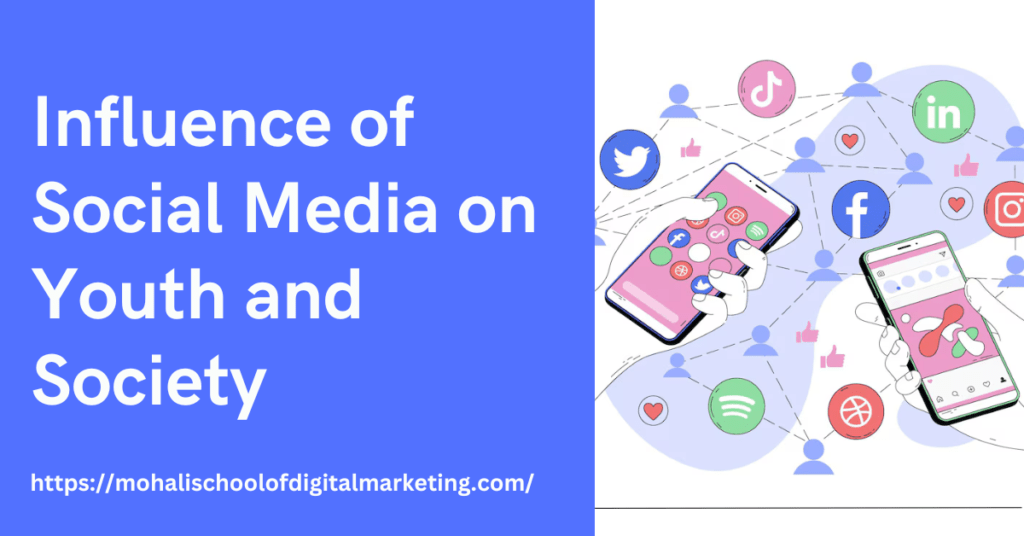Social media has been one of the most profound technological revolutions of the 21st century, shaping the way youth communicate, consume information, and perceive the world. By 2025, the influence of social media on both youth and society is expected to deepen even further. Platforms like Instagram, TikTok, X (formerly Twitter), and newer entrants are not only entertainment hubs but cultural and political drivers, significantly impacting individual behaviors, social norms, and societal frameworks.

Social Media Influence on Youth: Identity, Trends, and Mental Health
Youth, typically the most engaged demographic on social media platforms, are profoundly influenced by the online world. In 2025, this social media influence on youth is set to become more immersive and multifaceted, shaped by rapid technological advancements, AI-driven content curation, and the proliferation of virtual and augmented reality.
Identity Formation and Self-Esteem
The digital environment serves as a crucial stage for identity exploration. For today’s youth, identity is no longer forged solely through real-world interactions but also through the digital personas they create online. By 2025, the distinction between online and offline identities may blur even further with the rise of technologies like the Metaverse, where virtual avatars become extensions of an individual’s personality.
On one hand, social media offers youth unprecedented opportunities for self-expression, creativity, and the ability to connect with like-minded peers across the globe as well as social media helps our youth to represent their skills . Moreover, our youth make their career in social media and also influence other people too.On the other hand, there is growing concern about its negative impact on self-esteem. Platforms that prioritize visual content (like Instagram and TikTok) can foster a culture of comparison, where youth measure their self-worth against curated, often unattainable, representations of others’ lives.
Trends and Fads
Social media’s ability to dictate trends in 2025 is stronger than ever. From fashion and music to ideologies and lifestyle choices, platforms dictate what’s “in” or “out” at lightning speed. The fast-paced nature of trends can make it difficult for youth to find a stable sense of self, as they may feel pressure to constantly adapt to the ever-shifting cultural landscape. The rise of “micro-trends” and influencers has resulted in niche communities that push specific aesthetics, values, or behaviors, which can either influence youth find their tribe or alienate those who feel they can’t keep up.
Mental Health Concerns
The impact of social media on mental health remains a hot-button issue in 2025. The constant pressure to present a flawless version of oneself and the omnipresence of ‘like’ counts and engagement metrics contribute to rising anxiety, depression, and a fear of missing out (FOMO).
At the same time, mental health awareness has grown, with many social media campaigns dedicated to breaking the stigma around seeking help. In 2025, we see an increase in platforms that aim to create a more supportive and empathetic online environment and it also influences our youth for hard work. Mental health apps integrated into social platforms and AI-driven tools for identifying at-risk users may help combat some of these issues, although the balance between screen time and mental well-being remains precarious.
Social Media Influence on Society: Politics, Culture, and Community Building
Social media has transformed the fabric of society, affecting everything from political activism to consumer behavior. By 2025, its influence will be even more pronounced as it continues to act as a catalyst for societal change.
Political Mobilization and Misinformation
The political landscape in 2025 is heavily shaped by social media. What began as a platform for connecting friends has evolved into one of the most powerful tools for political mobilization. Activist movements, such as Black Lives Matter or Fridays for Future, have used social platforms to gain momentum, bypassing traditional media outlets to reach global audiences.
However, this ability to mobilize masses comes with its downsides. The rise of misinformation and fake news continues to be a growing concern. In 2025, deep fakes, AI-generated content, and highly sophisticated disinformation campaigns pose a threat to democratic processes. While platforms have increased their efforts to counteract these problems by implementing more stringent fact-checking and content moderation policies, the sheer volume of information makes complete regulation nearly impossible.
Cultural Shifts and Diversity
Social media has been influential in shifting cultural conversations toward greater inclusivity. Movements advocating for racial equality, LGBTQ+ rights, gender parity, and environmental justice have found a robust platform online. By 2025, social media continues to challenge outdated societal norms, giving marginalized voices a space to be heard and demanding accountability from institutions.
Platforms have embraced diverse content creators who challenge the status quo and provide representation to groups that were historically underrepresented in media. Youths are particularly drawn to influencers and public figures who embrace authenticity and transparency, pushing for cultural content that is real and relatable. This drive for inclusion and diversity reshapes the entertainment industry, fashion, politics, and even global business practices, as brands align themselves with socially progressive causes to connect with younger audiences.
Community Building in a Globalized World
In 2025, the role of social media in building communities is more critical than ever. As the world faces challenges like climate change, political unrest, and economic inequalities, people increasingly turn to online communities for solidarity and support. The internet provides a space where geographical boundaries dissolve, allowing people from different cultures and countries to unite around shared values and causes by which our society is influenced.
These virtual communities also offer support for niche interests, hobbies, or lifestyle choices that might not be widely understood in offline environments. Whether it’s a group of indie music lovers or a forum for young entrepreneurs, social media helps individuals find their “tribe” in a vast, globalized world.
However, this connectivity also has its downsides. While social media enables community building, it can also create echo chambers. Algorithms often prioritize content that aligns with users’ existing beliefs and opinions, creating a feedback loop that limits exposure to different viewpoints. This can lead to increased polarization and a fragmented society, where groups become more isolated in their ideologies.
The Future of Social Media in 2025 and Beyond: What’s Next?
By 2025, social media is not only a tool for communication but an integral part of everyday life that impacts nearly every facet of human interaction. As platforms evolve, driven by technological advancements such as AI, AR/VR, and blockchain, the lines between online and offline realities continue to blur.
Ethical Concerns and Regulations
In response to social media’s growing influence, society is expected to place more emphasis on ethical usage and regulation. Governments around the world are working on policies to safeguard privacy, combat online abuse, and hold platforms accountable for the content they host. Social media companies are increasingly facing scrutiny for their role in perpetuating harmful content, and regulatory oversight is expected to increase in 2025.
Evolving Consumer Behaviors
The influence of social media on consumer behavior has skyrocketed, especially with the advent of shoppable posts and influencer marketing. By 2025, social commerce—buying directly from social platforms—is a dominant force in the retail sector. Youth are more likely to discover new brands, trends, and products via influencers and social ads than through traditional marketing channels. Companies have adapted by investing heavily in social media marketing strategies that focus on user engagement and personalized experiences.
Hybrid Realities: Merging the Physical and Digital Worlds
One of the most exciting aspects of social media in 2025 is the fusion of the physical and digital worlds. The Metaverse, a collective virtual shared space, is expected to be a significant trend. In this space, users interact in real-time via avatars, attending virtual concerts, visiting digital art galleries, or even shopping for both virtual and physical products. This convergence of realities represents the next frontier for social media, offering immersive experiences that could redefine everything from education to entertainment.
Conclusion
The influence of social media on youth and society in 2025 is undeniable. While it has created opportunities for self-expression, community building, and social change, it has also introduced challenges related to mental health, misinformation, and societal fragmentation. As we move forward, the key to navigating this complex landscape lies in striking a balance between the benefits and the risks, ensuring that social media continues to evolve in a way that fosters connection, understanding, and positive societal impact.
In 2025 and beyond, social media will remain a defining force, shaping both the way we see ourselves and the world around us.

